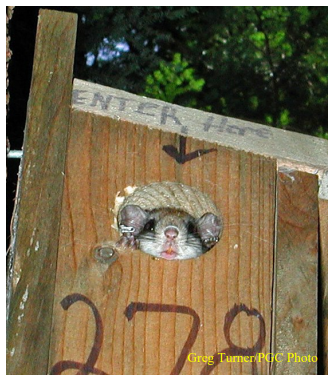
A northern flying squirrel in the Pennsylvania region nestled inside a nest box. Image: Greg Turner
By Caroline Miller
Ultrasonic acoustic detectors are being used to detect and identify the northern flying squirrel that is endangered in Pennsylvania.
The detectors, first used to track bats, pick up ultrasonic, high frequency call types from northern flying squirrels that humans can’t hear. The recordings are analyzed to distinguish the call type and the specific species, said Mario Giazzon, the wildlife diversity biologist in the North Central region for the Pennsylvania Game Commission.
“That’s what kind of spurred me on is like, oh, well this is pretty cool,” Giazzon said. “You just throw these detectors out, and you can find an endangered species.”
The most common call type picked up by the detectors is called a whistle, but the trill call is what distinguishes the northern flying squirrel from the southern flying squirrel, Giazzon said. The trill call consists of rapid, high-pitched chirps only the detectors can pick up, he said.
“The trill call is primarily emitted during the breeding season and then post-nesting season,” he said.
The peak time for finding these trill calls is in May and June, Giazzon said.
During this period, the detectors are placed in suitable habitats for two weeks at a time to record targeted frequencies from the species, resulting in a massive amount of data to sift, he said.
“It’s kind of like Christmas,” Giazzon said.
The detectors are set to record at night and only when a frequency triggers it, Giazzon said.
“There’s a lot of mind numbing, tedious work, you know, sitting at the computer looking at these files to see if you’ve picked something up,” Giazzon said. “The nice thing is, and the great thing is, there are software programs now that you can run these calls through.”
Giazzon said the detectors are an effective, noninvasive technique to survey the presence of northern flying squirrels, but the Pennsylvania Game Commission is looking for ways to improve it.
“We’re working on looking into the acoustics a little bit more and taking it a step further, and sort of develop some more protocols or a little bit more guidance on how to do this,” Giazzon said.
Giazzon said in 2020, he put detectors in areas where the northern flying squirrel was assumed to be gone in the state, but to his surprise, the detectors picked up calls from the species in many spots.
This year Giazzon said he is going back to the areas where he had the most success and will put the detectors out in mid-April to test if he picks up more trill calls.
In addition to the detectors, the Pennsylvania Game Commission uses nest boxes and live-trapping to corral the species and obtain more information on them, he said.
Northern flying squirrels prefer old-growth boreal forests that contain coniferous trees, moist soils and downed woody debris from dead trees, according to the Pennsylvania Game Commission species profile.
Another useful tool in data collection is camera traps, or trail cams, said Greg Lipps, the amphibian and reptile conservation coordinator at Ohio State University.
Lipps’ research is on using camera traps to monitor snakes, but he said he found that the cameras are picking up data on small mammals as well.
“I have no doubt that there’s very good ways to use them for things like northern flying squirrels,” Lipps said.
Camera traps are cost efficient and collect massive amounts of data on many different species, Lipps said.
“Camera traps have kind of revolutionized wildlife biology,” Lipps said.
Using ultrasonic acoustic detectors, nest boxes, live-trapping and trail cams, the Pennsylvania Game Commission knows that the Pocono region in Pennsylvania has only 39 northern flying squirrels, and is where most of the species live, Giazzon said.
The northern flying squirrel is found primarily in the Northeast, endangered in Pennsylvania. The southern flying squirrel is not endangered, Giazzon said.